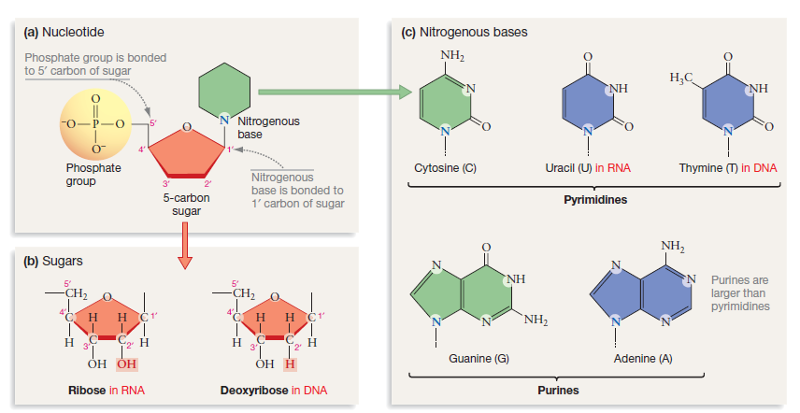1
What are the three components of a nucleotide?

- The three components are a phosphate group, a five carbon
sugar, and a nitrogenous base.
- The phosphate group is bonded to the sugar molecule which is then bonded to the nitrogenous base.
2
Which of these components are found in both RNA and DNA?
Which are found only in DNA or RNA?
All of them are found in both RNA and DNA, except DNA has a deoxyribose sugar instead of ribose in RNA.
3
Primary structure of RNA
- When the nucleotides involved in a phosphodiester linkage contain the sugar ribose, RNA is produced but when they contain deoxyribose, DNA is produced.
- The additional -OH group on ribose makes it much more reactive and supports RNA’s catalytic activity by making it less stable.
- The pyrimidine base thymine is replaced by uracil in RNA.
4
Secondary structure of RNA
- The purine and pyrimidine bases in RNA undergo hydrogen bonding with complementary bases on the same strand
- RNA secondary structures can form spontaneously because the energy released makes the whole process favorable
5
Tertiary structure of RNA
RNA can have a tertiary structure that results when secondary structures fold into more complex shapes.
6
Describe the secondary structure of DNA.
- Formed by hydrogen bonding between the nitrogenous bases.
- Antiparallel: the two strands of DNA are side by side and running in opposite directions
- One strand ran in the 5’ → 3’ direction while the other ran in the 3’ → 5’ direction
- Double helix: formed when the antiparallel strands are twisted together
- The coiled sugar-phosphate backbones end up on the outside of the spiral and the nitrogenous bases on the inside
- Maintained by hydrogen bonding between complementary bases
- Complementary pairing: for the bases of each backbone to fit in the interior, they have to form purine-pyrimidine pairs.
- This pairing allows adenine to form two hydrogen bonds with thymine and guanine forms three hydrogen bonds with cytosine.
- Base pairing: Van der waals interactions between the tightly stacked bases in the interior further contribute to the stability of the helix
7
Explain the statement, “DNA functions as an information-containing molecule."
- DNA carries the information required for an organism’s growth and reproduction in the sequence of nucleotides.
- The four nitrogenous bases function like letters in the alphabet.
8
Can RNA or DNA function as a catalytic molecule? Explain in the context of molecular and structural properties.
- Only RNA can function as a catalytic molecule because DNA’s structure is very stable while RNA’s structure is versatile.
- The -OH group in RNA makes it much less stable than DNA and also can support its catalytic function.
- RNA has a tertiary structure therefore RNA molecules with different base sequences can have very different overall shapes and chemical properties.